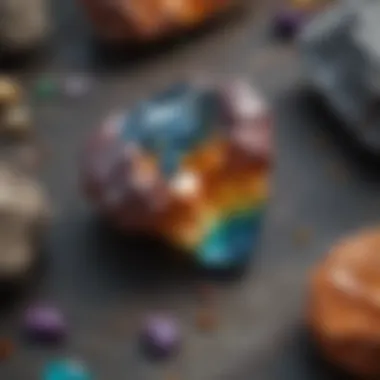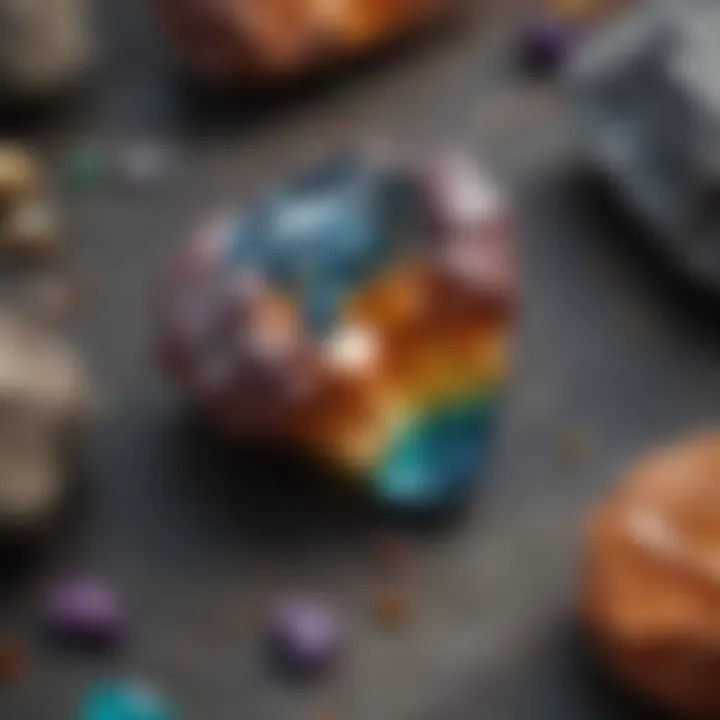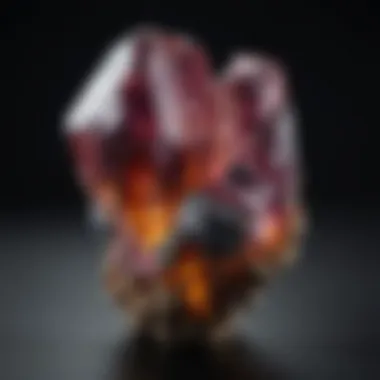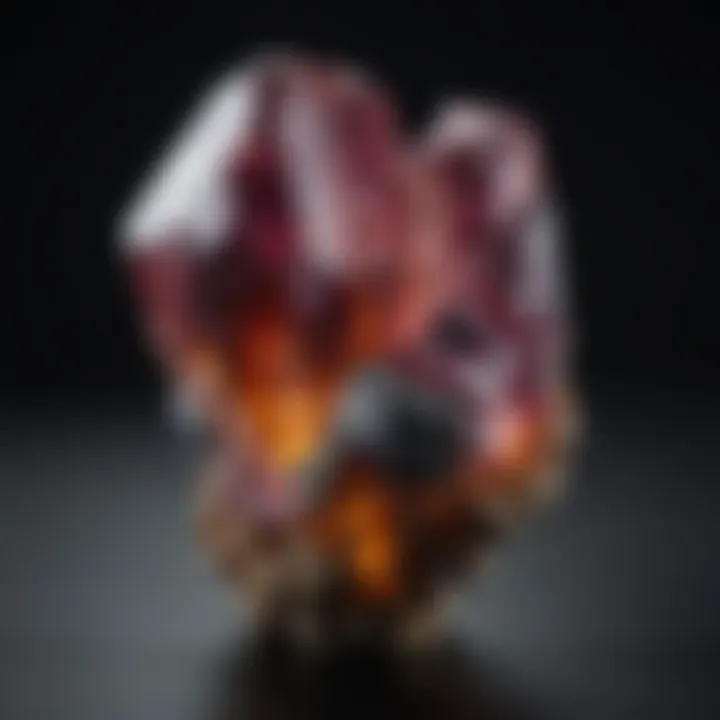Exploring Rare Minerals: Classification and Significance


Intro
The world of rare minerals presents a fascinating landscape for exploration and appreciation. This topic encompasses a variety of minerals that are not only geologically unique but also hold significance across various fields, such as geology, industry, and art. Understanding these minerals allows enthusiasts and professionals alike to appreciate their properties, uses, and the complexities surrounding their formation.
In this article, we will systematically explore the classifications of rare minerals, delve into their distinctive characteristics, and examine the important roles they play. It is essential to establish a rigorous perspective on the types of minerals discussed, how they form, where they are found, and their historical importance.
Various minerals will be highlighted throughout this narrative, offering insights into their origins and significance. From gemstones to minerals used in industry, each has a unique story tied to Earth's geological processes. Each section aims to equip the reader with valuable knowledge, whether they are gemology enthusiasts or professionals in related fields.
Gemstone Overview
Definition and characteristics
Gemstones are precious or semi-precious stones that have been cut and polished for decorative purposes. These minerals are often valued not just for their beauty but also for their rarity and unique qualities. A gemstone often undergoes various treatments, enhancing its appearance and durability, making it suitable for jewelry and ornamentation.
The characteristics that define gemstones include:
- Color: The hue can significantly affect a stone's value.
- Clarity: The presence of inclusions or blemishes can impact clarity, influencing desirability.
- Cut: The quality of the cut affects the gem's brilliance and sparkle.
- Carat weight: Heavier stones tend to be rarer and often command higher prices.
Classification of gemstones
Gemstones can be classified into different categories based on their origins. The main categories include:
- Natural gemstones: Formed through geological processes, such as crystallization. Examples include diamonds and sapphires.
- Synthetic gemstones: Man-made stones created for various purposes, such as lab-created rubies and emeralds.
- Organic gemstones: Derived from living organisms, such as pearls and amber.
Understanding these classifications is vital for both collectors and professionals in the field. It provides insight into sourcing, valuation, and the market dynamics that govern the gemstone industry.
Properties of Gemstones
Physical properties
Physical properties play an essential role in determining how gemstones are perceived, especially in terms of durability and aesthetics. These properties include hardness, luster, and specific gravity.
- Hardness: Measured by the Mohs scale, this indicates how scratch-resistant a gemstone is.
- Luster: Refers to how light interacts with the surface, including the shine and gleam of the stone.
- Specific gravity: This is the ratio of the weight of the gemstone to the weight of an equal volume of water, providing a measure of density.
Chemical properties
Chemists analyze the chemical composition of gemstones to understand their formation and potential uses in industry. Key aspects include:
- Composition: Elements that make up the gemstone, impacting its color and durability.
- Reactivity: Some gemstones may exhibit reactions to heat or chemical exposure, affecting their usability.
- Isotope ratios: Used in determining the age and origin of the mineral.
These properties are crucial in both academic research and the practical applications related to gemstones, influencing decisions in jewelry design and mineral collection.
"Gemstones are not merely beautiful; they are geological wonders holding centuries of history within them."
By delineating these aspects of rare minerals, this narrative underscores their multifaceted roles in various contexts, inviting a deeper appreciation and understanding of these geological treasures.
Prelude to Rare Minerals
Rare minerals hold a unique position within the broad spectrum of geological studies. Their complexity, scarcity, and specific characteristics make them worthy of in-depth exploration. Understanding rare minerals is essential for not only gemology enthusiasts but also for those involved in various industrial applications. The interest in these minerals extends beyond their aesthetic value, shedding light on their economic, environmental, and cultural implications.
Definitions and Characteristics
Rare minerals can be defined as those naturally occurring inorganic substances that are not commonly found in the earth's crust. The term 'rare' can refer both to limited occurrence and unique chemical properties that set them apart from more common minerals. Often, these minerals exhibit striking colors, unusual structures, or specific physical properties that are desirable in both industrial applications and decorative uses.
The classification of rare minerals usually includes aspects like their crystalline structure, chemical composition, and the environments in which they form. For example, minerals such as painite, red beryl, and benitoite exemplify these unique characteristics.
Importance of Studying Rare Minerals
Studying rare minerals offers several important benefits, notably in fields such as geology, ecology, and material sciences. First, these minerals can be indicators of geological processes, helping geologists understand earth's history. The conditions under which they form provide insights into the earth's crust and the dynamic processes that shape it.
Second, the rarity of these minerals elevates their market value and fosters economic interest. As industries like electronics and renewable energy grow, the demand for rare minerals like tantalum, lithium, and cobalt increases. This makes understanding the sourcing, geological distribution, and market dynamics of these minerals crucial for informed investment and policy-making.


Lastly, many rare minerals hold significant cultural and historical importance. They have been used in art, jewelry, and cultural artifacts for centuries, solidifying their role in human history.
To understand rare minerals is to appreciate the interplay between nature, economics, and culture.
Classification of Rare Minerals
Classifying rare minerals is a fundamental process that aids in understanding their characteristics and applications. This classification is pivotal as it helps researchers and enthusiasts to identify and study these minerals effectively. Different classification systems allow for the prioritization of notable traits, including chemical composition and structural aspects. Each classification reveals insights into the formation, rarity, and potential uses of these minerals. Understanding how rare minerals are classified is essential for their applications in various fields, from gemology to industry.
Based on Chemical Composition
Classifying rare minerals based on their chemical composition offers a structured approach. This perspective emphasizes fundamental aspects that dictate their properties and uses.
Ionic Minerals
Ionic minerals are characterized by the presence of charged ions. They are crucial in various applications from electronics to environmental science. One key characteristic of ionic minerals is their high solubility in water, making them beneficial for both industrial and environmental chemistry. Their unique feature lies in their tendency to form salts and crystals, which are essential for various chemical reactions. However, their solubility can also pose challenges in mineral conservation and usage in specific contexts.
Silicate Minerals
Silicate minerals account for a significant portion of Earth’s crust. They primarily consist of silicon and oxygen, often in complex structures. This makes them valuable for their durability and abundance. A notable characteristic of silicate minerals is their diversity in forms, which range from simple quartz to complex feldspar compounds. Their unique crystal structures allow them to be utilized in ceramics, glass, and even electronics, demonstrating their versatility. Nevertheless, the complexity of their structures can complicate their identification and extraction.
Sulfide Minerals
Sulfide minerals, consisting of metals combined with sulfur, play a critical role in ore formation. They are essential resources for several industries, particularly mining. One of the critical characteristics of sulfide minerals is their metallic luster and high density, which make them easily recognizable. They often present unique features such as the ability to conduct electricity, which makes them interesting for technological applications. However, their extraction often involves significant environmental concerns and economic considerations.
Based on Structure
Another vital way to classify rare minerals is by their structural characteristics. This aspect provides insight into their physical properties and potential uses.
Crystalline
Crystalline minerals are known for their orderly and repeating structure. This regularity leads to distinct geometric shapes, making them appealing to collectors and gem enthusiasts. A defining characteristic of crystalline minerals is their relationship with light, which often results in beautiful optical effects. This promotes their use in jewelry and decorative items. However, their formation often requires specific conditions, which can limit availability, influencing market dynamics and rarity.
Amorphous
Amorphous minerals lack a defined crystalline structure, leading to a different set of properties and uses. They exhibit unique features, such as being less brittle compared to their crystalline counterparts, making them useful in various applications like adhesives and coatings. One of the key characteristics of amorphous minerals is their ability to be easily molded during production. This flexibility can make them advantageous in industrial settings, but their lack of structure can also make them less desirable for collecting due to the perceived lesser aesthetic value.
Notable Rare Minerals
Rare minerals hold significant value in both scientific and commercial spheres. Understanding these minerals is essential for gemologists, collectors, and industry professionals. These uncommon geological formations can offer insights into Earth's processes and have practical applications in technology and industry. The following sections will delve into the characteristics and relevance of notable rare minerals: Painite, Red Beryl, Benitoite, Grandidierite, and Taaffeite.
Painite
Painite is recognized as one of the rarest minerals on Earth. This borate mineral, discovered first in Myanmar, boasts a unique red-brown hue. Its rarity stems from limited deposits. As a result, only a few crystals have been found. Painite's appeal goes beyond its color; it is also valued for its optical properties, which include a high refractive index. This attribute makes it attractive for collectors and jewelers. Nevertheless, due to its scarcity, Painite often commands a high price in the market, making quality specimens a sought-after treasure.
Red Beryl
Red Beryl, also known as Bixbite, is another striking example of a rare mineral. This gem is predominantly found in Utah, USA, known for its vibrant red color. The striking appearance of Red Beryl is often compared to that of Ruby, but it is significantly rarer. With an estimated occurrence ratio of 1,000 to 1, compared to Ruby, it is prized by collectors. In addition to its color, Red Beryl's transparency and brilliance make it a desirable choice for jewelry. It is important to mention that processes for synthetically producing Red Beryl have not been successful, which adds to its appeal and value.
Benitoite
Benitoite is famed for its captivating color, which ranges from a bright blue to a deep sapphire shade. It was discovered in California in the 1900s and is the state gemstone. This mineral is particularly notable for its rare crystal structure and high dispersion, which allows it to display exceptional fire. While Benitoite was once used in jewelry, its limited availability—attributed to its specific geological conditions for formation—has led to its classification primarily as a collector's item. Its rarity continues to intrigue gem enthusiasts and mineral collectors alike.
Grandidierite
Grandidierite is a fascinating mineral that exhibits an unusual greenish-blue color. Discovered in Madagascar, it is valued for its rarity and pleasing aesthetic. Grandidierite crystals are often very small, ranging from transparent to translucent. Its beauty, coupled with its limited availability, makes it an appealing choice for collectors. The mineral is also notable for its distinctive pleochroism—showing different colors when viewed from different angles—which further enhances its allure.
Taaffeite
Taaffeite is a rare mineral that was initially mistaken for Spinel. It can be found in a range of colors, including purple, blue, and pink. The origin of its name comes from gemologist Edward Taaffe, who first identified it. Its rarity is evident, as very few natural specimens have been found. Taaffeite's complexity in classification adds depth to its study. Additionally, its unique colors and brilliance make it a captivating choice for gem collectors and jewelry enthusiasts. The mineral’s limited sources and occasional finds in alluvial deposits contribute to its high market value.
"Rare minerals like Painite and Red Beryl provide not only beauty but also represent significant geological and historical narratives."
Understanding these notable rare minerals enhances appreciation for the intricate world of gemology and the practical roles these minerals play across various sectors. Their rarity and aesthetic qualities combine to form a fascinating field of study that continues to attract interest from professionals and amateurs alike.


Formation and Sources of Rare Minerals
The formation and sources of rare minerals are fundamental elements in understanding their characteristics and significance. The geological processes that lead to the formation of these minerals provide insights into how they are created and where they can be found. Grasping this information is essential in distinguishing their different types, aiding in their identification and facilitating effective mining strategies.
Geological Processes
Metamorphic
Metamorphic minerals result from the transformation of existing rock types due to increased temperature and pressure. This process can change the mineralogy and texture of the initial rock, creating new minerals that are often rarer than their parent materials. A key characteristic of metamorphic processes is their ability to produce minerals like garnet and kyanite, which can be found in high-grade metamorphic environments. The diversity and beauty of these minerals make them appealing in the context of jewelry and collectors. One notable advantage of studying metamorphic minerals is their stability under varying conditions, making them valuable specimens for both collectors and gemologists. However, their complex formation means these minerals are often limited to specific geographical areas, which can constrain accessibility.
Igneous
Igneous minerals form from the cooling and solidification of magma or lava. This happens either below the Earth’s surface, creating intrusive rocks like granite, or on the surface as volcanic rocks like basalt. The key characteristic of igneous minerals is their crystalline structure, which can result in striking colors and patterns. Common examples include quartz and feldspar. These minerals are popular among collectors due to their aesthetic appeal and common occurrence. The unique feature of igneous processes is the occasional occurrence of rare minerals such as zircon or peridot, which can be found in specific volcanic regions. The advantage of igneous minerals is their abundance in the Earth's crust, facilitating mining efforts. However, the volatility involved in their formation can make some deposits challenging to access.
Sedimentary
Sedimentary minerals originate from the residues of weathered rocks or biogenic materials that accumulate in layers over time and then are compacted and cemented. They are essential in understanding the Earth's history and environments. A key characteristic of sedimentary minerals includes the preservation of fossilized remains, which can offer insights into the life forms that existed in the past. Examples include limestone and sandstone as well as rare minerals like tar sand. The unique feature here is the often stratified layering, which aids in the identification of different geological periods. This characteristic can be an advantage for geologists and collectors in tracing the history of mineral deposits. However, finding truly rare sedimentary minerals can be a challenge, as they are often buried under thick layers of more common minerals.
Geographical Locations
Unique Deposits Around the Globe
The rarity of minerals is often linked to their specific geographical locations, where certain conditions facilitate their formation. Some notable deposits of rare minerals include the Himalayas, which is home to unique deposits of Taaffeite, and the USA, where Benitoite is found. A key characteristic of these unique deposits is their often restricted distribution, leading to a scarcity that can drastically affect their market value. This characteristic not only highlights the geological diversity across the globe but also underscores the importance of preserving such locations. The benefits of exploring these deposits lie in the discovery of new varieties and qualities of minerals, advancing both science and gemology. However, geographical constraints and local regulatory frameworks can complicate mining efforts.
Mining Challenges
Mining for rare minerals presents numerous challenges due to the varied conditions under which these minerals form. One specific aspect of Mining Challenges involves the economic feasibility of extraction, as rare minerals are often located in remote or environmentally sensitive areas. A key characteristic of these challenges includes the high capital and technical requirements for extracting minerals like Painite. The extraction processes can not only be costly but may also have significant environmental repercussions. The unique feature of these challenges is the need for specialized tools and techniques to safely and effectively extract these minerals. These concerns significantly impact the viability of many mining projects.
In summary, understanding the formation and sources of rare minerals enriches the knowledge of their origins and availability. This foundation is crucial for gemstone enthusiasts and collectors who seek to appreciate the complexities behind their selection and usage.
Cultural and Historical Significance of Rare Minerals
The cultural and historical significance of rare minerals represents a rich tapestry woven through the ages. These minerals have served not just as aesthetic enhancers but also as symbols embedded with deeper meaning across diverse societies. Understanding their importance requires exploration into both their practical uses and their symbolic meanings. This inquiry connects the past to contemporary understanding, enriching our appreciation for these distinct geological items.
Historical Uses in Jewelry and Art
Throughout history, rare minerals have found a place in jewelry and art, often reflecting the cultures that revered them. Painite and Benitoite, for instance, are not only sought for their rarity but for their vibrant colors and unique properties that enhance aesthetic expressions in various art forms. In many ancient civilizations, gems were thought to possess mystical properties.
- Symbol of status: Precious stones like emeralds, sapphires, or diamonds were traditionally worn by royalty to showcase wealth and power.
- Cultural significance: Different minerals represented specific cultural beliefs or status. For example, jade in Mesoamerican cultures symbolized life and fertility.
- Artistic expression: Many historical artifacts, ranging from jewelry to ceremonial artifacts, contained rare minerals. Artists have incorporated these elements into sculptures, masks, and elaborate crafts.
This multifaceted use of rare minerals not only adds beauty but also tells stories, connecting the observer to historical periods and societal values. The incorporation of these minerals into significant cultural artifacts helps preserve their legacy in ways that continue to attract attention today.
Contemporary Cultural Importance
In contemporary settings, the cultural importance of rare minerals shifts but remains potent. They are not just appreciated as collectibles or fashion statements; they signify a deeper connection to environmental and ethical issues. Awareness of these factors plays a crucial role in how society views these geological treasures today.
- Sustainability: Many collectors and designers now prioritize ethically sourced minerals, reflecting a growing consciousness about environmental impacts.
- Personal significance: People often associate personal memories or experiences with specific minerals, giving them deeper emotional value beyond mere aesthetics.
- Economic value: Rare minerals contribute significantly to economies through trade, mining, and tourism, linking the cultural experience to financial considerations.
"Rare minerals not only constitute geological marvels; they embody our history and our diverse cultural narratives."
Economic Impact of Rare Minerals
The economic consequences of rare minerals are extensive and multifaceted. These minerals play a key role in numerous industries, from technology to aerospace, influencing market trends, employment rates, and even national economies. The extraction, processing, and trade of rare minerals contribute significantly to global commerce. As these resources are vital for various applications, understanding their economic implications is essential for investors, manufacturers, and policymakers.
Market Value and Trade
Rare minerals have a high market value, often due to their scarcity and the specialized technology required for their extraction and processing. This high value arises from several factors:
- Supply and Demand: The fluctuating demand for rare minerals, often driven by technological advancements, affects their market prices significantly.
- Global Trade Relationships: Countries rich in these minerals often engage in trade agreements that enhance their economic standing on the international stage.
- Investment Opportunities: The rarity of these minerals has attracted investments in mining projects and technology development, which can lead to substantial economic growth in mining regions.
The trade dynamics of rare minerals are complex and influenced by geopolitical factors. Governments may impose trade restrictions, tariffs, or export quotas to control the flow of these strategically important resources. Understanding these dynamics is crucial for navigating the economic landscape surrounding rare minerals.


Applications in Industry
Electronics
Electronics is one of the largest consumers of rare minerals. Elements like indium, tantalum, and gallium are integral to the production of semiconductors and other electronic components. The characteristics of electronics make them ideal for incorporation of rare minerals:
- Key Characteristics: High efficiency and miniaturization of devices require rare minerals that can perform under demanding conditions.
- Beneficial Choice: The demand for innovative electronics drives the need for rare minerals, ensuring a steady market for these resources.
- Unique Feature: Their use in electronic devices enhances performance, but economic instability can arise from sudden mineral shortages.
Aerospace
The aerospace industry heavily relies on rare minerals for the manufacture of lightweight and durable materials. These minerals contribute to the overall performance and safety of aircraft and spacecraft:
- Key Characteristics: High strength-to-weight ratios are critical for aerospace applications.
- Beneficial Choice: Rare minerals like titanium and rare earth elements improve fuel efficiency and are crucial for advanced aerospace technologies.
- Unique Feature: While possessing excellent properties, the extraction processes of these minerals can be environmentally challenging, raising ethical concerns.
Renewable Energy
Rare minerals are equally important in the renewable energy sector, especially in the production and efficiency of solar panels, wind turbines, and batteries:
- Key Characteristics: Minerals like lithium and cobalt are essential for energy storage systems, which are pivotal in a sustainable energy future.
- Beneficial Choice: As the world shifts towards renewable energy, the demand for these minerals is projected to rise significantly.
- Unique Feature: However, reliance on rare minerals in renewable technologies can lead to resource constraints and potential environmental degradation if not managed properly.
The economic impact of rare minerals extends beyond basic financial metrics, influencing global power dynamics and technological advancement.
In summary, rare minerals wield a considerable influence on our global economy. Their market value and applications are critical to discussions around future technological trends and environmental sustainability. Understanding their economic impact provides valuable insights for various stakeholders within the industry.
Challenges in Sourcing Rare Minerals
Sourcing rare minerals presents various challenges that can significantly impact their availability and market value. Understanding the specifics of these issues is crucial for stakeholders, from gem enthusiasts to industry professionals. The primary challenges include environmental concerns and the necessity for ethical sourcing practices. Both elements weigh heavily on the future of the rare minerals market, affecting sustainability and economic viability.
Environmental Concerns
The extraction of rare minerals often leads to substantial environmental degradation. Mining activities can disrupt local ecosystems, leading to loss of biodiversity. Trees are cleared, soil erosion occurs, and local water sources may become polluted. These environmental impacts require rigorous assessments and mitigation strategies. The demand for minerals like Grandidierite or Painite can lead to over-exploitation of specific regions, which may have long-lasting consequences.
Moreover, the carbon footprint associated with mining operations contributes to climate change. The use of heavy machinery and transportation contributes significantly to greenhouse gas emissions. Thus, it is important to evaluate these environmental concerns seriously. It is not only about mining minerals but also about preserving the planet for future generations. Stakeholders must consider the ecological footprint of their endeavors.
Ethical Sourcing Practices
Ethical sourcing practices are becoming increasingly important in the mining sector. Consumers today are more aware of the conditions under which minerals are sourced. They often seek assurance that their purchases do not support exploitation or human rights abuses.
The industry faces the challenge of ensuring that minerals like Red Beryl and Benitoite are sourced responsibly. This involves conducting thorough audits of supply chains and ensuring that all workers are treated fairly. Furthermore, companies must engage with local communities to ensure that they benefit from mining operations, rather than suffer due to them.
To achieve ethical sourcing, certain guidelines can be followed, such as:
- Transparency in supply chains: Companies should disclose their sourcing methods and locations.
- Ongoing audits: Regular ha audits can ensure compliance with ethical standards.
- Community involvement: Collaborating with local populations can lead to more grounded and sustainable practices.
“The quest for rare minerals is not just about acquiring valuable resources; it also entails a responsibility to safeguard ethical standards.”
By addressing these challenges, the industry can move toward a more sustainable future. When stakeholders prioritize environmental care and ethical practices, they not only enhance their reputations but also contribute to a healthier planet. This balance is crucial for the long-term sustainability of rare mineral sources and the health of the communities involved.
Analyzing the Future of Rare Minerals
The future of rare minerals stands at a critical juncture. Several factors influence the trajectory of these geological treasures, ranging from technological advancements to shifting economic landscapes. Understanding these elements is essential for various stakeholders, including gemology enthusiasts, industry professionals, and collectors. As demand for rare minerals increases, so does the need to explore sustainable practices and innovative extraction techniques. This section dissects the future, focusing on significant trends and prospects.
Technological Advancements
Technological innovation is reshaping how we access and utilize rare minerals. New extraction methods are developing, making it possible to procure more rare minerals with less environmental impact. Technologies such as drone surveying and advanced mineral processing techniques enhance efficiency. These advancements help in identifying mineral deposits that were previously deemed unreachable or economically unviable.
Moreover, synthetic alternatives are making their way into the market. While natural rare minerals hold distinct value, synthesized stones can sometimes offer a more sustainable option. As the technology improves, the lines between natural and synthetic may become increasingly blurred, prompting discussions about authenticity, value, and ethics.
Emerging Markets and Trends
The interest in rare minerals is not limited to traditional markets. Emerging economies, particularly in Asia and Africa, are showing considerable demand for rare minerals. Countries like China and India are witnessing a surge in demand for rare earths, fueling growth in their local industries.
In addition, there is a noteworthy trend toward sustainability and ethical sourcing in consumer purchasing decisions. New consumers prioritize transparency regarding the origin and extraction processes of rare minerals. Brands and organizations highlighting their commitment to ethical practices may find a more loyal customer base.
Potential collaboration between governments, private institutions, and organizations will drive this change. Initiatives to establish regulations and standards for sourcing are developing. Such measures can enhance the integrity of the industry while also promoting responsible consumption.
"The demand for transparency and ethical sourcing in the rare minerals market may redefine how miners and collectors approach their business."
As new markets emerge and existing ones evolve, the future of rare minerals remains dynamic. By understanding technological advancements and shifting consumer trends, stakeholders can better navigate this complex landscape.



